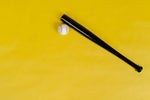
How to Play Outfield Like a Pro: Tips and Strategies for All Levels
, by Brad Purcell, 10 min reading time

, by Brad Purcell, 10 min reading time
Playing the outfield in baseball is a vital defensive role, requiring a unique set of skills, agility, and awareness. Outfielders are responsible for covering vast ground, reacting to balls hit into the outfield, and preventing runners from advancing on base. Whether you're a beginner or an experienced player looking to refine your outfield skills, this guide shares essential tips and strategies to enhance your game and become a well-rounded outfielder.
Outfielders must develop a wide range of physical and mental skills to excel in their defensive position. Outfield skills such as speed, hand-eye coordination, and quick reflexes are fundamental. Additionally, field awareness and the ability to read fly balls off the bat are key attributes that defensive outfielders need to master.
Buy high-quality baseball equipment online
Preparation begins before the first pitch. Proper pre-game preparation helps outfielders anticipate and position themselves for different types of fly balls and base hits. Studying the opposing team's hitting tendencies can provide insights into where a ball hit might land. Reviewing the pitchers' game plan for the day also helps outfielders anticipate where the batter might try to hit the ball.
In the outfield, players should visualize different game scenarios during warm-ups. This helps develop muscle memory and prepares the body for quick, instinctive reactions. Professional outfielders often spend time mentally preparing by visualizing themselves catching routine fly balls, throwing runners out at 2nd base, and positioning themselves for deep drives or shallow fly balls.
One of the most important aspects of outfield defense is moving efficiently to the ball. Outfielders must be able to react immediately and take valuable steps to reach the ball quickly, whether it’s a shallow fly ball or a deep drive to the warning track.
Professional outfielders develop a keen ability to read the trajectory of the ball as soon as it leaves the bat. Recognizing the type of hit—whether it’s a line drive, routine fly ball, or ball hit deep—helps fielders determine their route and speed to the ball. Defensive outfielders should be adept at distinguishing between the various types of fly balls, such as shallow pop-ups or towering shots to the fence.
From a player standpoint, it’s important to avoid drifting with the ball, as this slows down reaction time. Instead, outfielders should run hard to a default spot where they anticipate the ball will land. This approach allows for a smoother, more controlled play on the ball.
Backing up other players is a critical component of outfield defense. The center fielder is typically responsible for covering the most ground, but all outfielders must be ready to back up infielders and each other to prevent extra bases on missed throws.
An essential part of outfield defense is delivering a strong and accurate throw to prevent runners from advancing or scoring. Outfielders must develop good throwing mechanics, such as using the crossover step for momentum and ensuring a direct throw to the correct base.
Outfielders should practice different types of throws, including the rainbow throw (a high-arching throw with distance) and a hard, low throw for shorter distances. Making the right throw depends on the game situation, the location of the runners, and the outfielder’s position on the field.
Effective communication between outfielders is key to avoiding collisions and ensuring the right fielder makes the play. Outfielders should call for the ball loudly to avoid confusion. The center fielder often takes the lead in directing the other outfielders, as they have the best view of the field and play a crucial role in cutting off balls hit between the left fielder and right fielder.
Outfielders need specific gear to perform at their best and stay protected. From the right glove for quick plays to essential protective items, having the proper equipment is key. Baseball360 stocks a wide range of top-quality gear for all positions, ensuring outfielders have everything they need for success and safety.
The best catcher gear for baseball and softball
At Baseball360, we provide everything you need to elevate your game, no matter your position. From essential gear to specialized equipment, we’ve got you covered. We offer a wide selection of high-quality products designed to help you perform your best, whether you’re playing infield or outfield.
You can shop online for:
Our carefully curated selection ensures that players of all levels can find exactly what they need. Visit our online store and discover how Baseball360 can support your success on the field!


